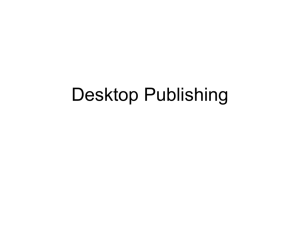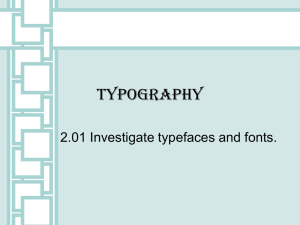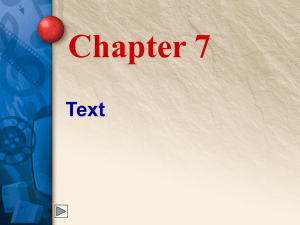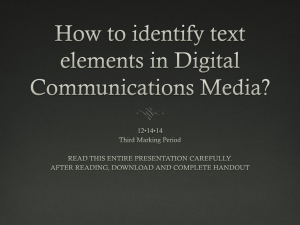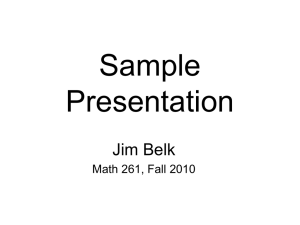Intro to Typograhy
advertisement
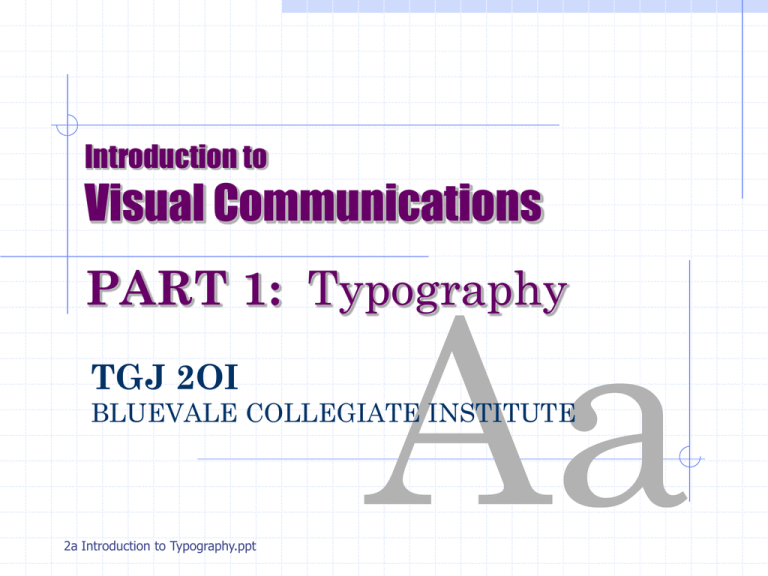
Introduction to Visual Communications PART 1: Typography TGJ 2OI BLUEVALE COLLEGIATE INSTITUTE 2a Introduction to Typography.ppt Intro to Typography (write blue text) We often don’t pay much attention to typography, but it can dramatically affect how we react to an ad, poster, package or text. Type forms the basis for many designs. Designers are careful to choose type styles that suit the purpose of their designs. The type should fit the “mood” of your work (suggests feeling). Intro to Typography Regardless of type uses or purpose, you want to make sure your text is readable. Fonts are measured in POINTS (72 points = 1 inch) Intro to Typography 1. 2. 3. 4. All type faces, or FONTS, can be placed in one of four FONT FAMILIES. Serif Sans Serif Script Decorative / Novelty Intro to Typography 1. SERIF Fonts: Aa Fonts in this family are categorized by tiny “feet,” called serifs, on the ends of letter lines. Includes fonts like Times New Roman Good for use as BODY TEXT – small type for articles, etc. (easy to read when small – 10-12pt) serif (feet) Intro to Typography 2. SANS SERIF Fonts Fonts in this family are sometimes called BLOCK letters – no feet on ends of letters Includes fonts like Arial and Helvetica Suitable for HEADLINES Not easy to read when smaller or larger font sizes Aa than 12pt – avoid use as body text (except for web pages) Intro to Typography 3. SCRIPT Fonts Fonts in this family look like Ex. – fancy handwriting Letters are joined together and flow smoothly Use sparingly (too much gets annoying) Never use as all capitals (difficult to read) or as body text Aa Commercial Script BT Intro to Typography 4. DECORATIVE / NOVELTY Fonts Fonts in this family are unusual Usually “trendy” or “funky” fonts such as, Jokerman, Slipstream. Use sparingly – for emphasis and don’t fit into other categories or interest on a page Never use these as body text Can evoke many types of moods (fun, scary, cool) Aa Aa Aa Intro to Typography Font Styles: You can change a font’s appearance by using styles: 1. BOLD – letter lines are heavier (stand out) 2. Italic – letters have a slight lean to the right 3. Underline – kinda’ obvious 4. You can also stretch fonts or change the space (kerning) between letters to give a different appearance or weight to text. Styles create variety without cluttering a document with too many fonts. Intro to Typography General Rules to Follow: Avoid using more than 3 fonts on one page. Using too many fonts may make a document/publication look cluttered or sloppy) Avoid using 2 fonts from the same family close together (use styles of same font if possible) Make sure you use consistent type sizes for longer publications (brochures, newsletters, etc.) Try to manipulate fonts (stretch, space letters apart, etc.) or add styles to create visual interest instead of adding different fonts to a page Intro to Typography TYPE ASSIGNMENT #1: Look through old magazines or newspapers to find at least 2 samples (large if possible) of fonts from each of the 4 font families (min. 8 total) For each sample, record where you found it and what purpose you think it had in the publication, ad, etc.


